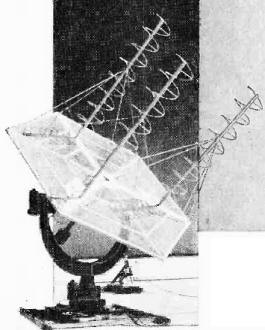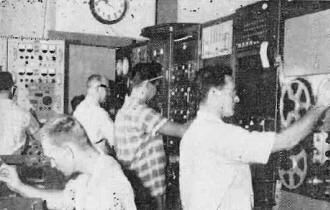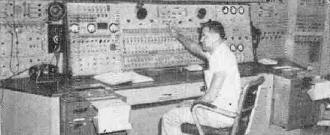Electronics - Vital to Missile Control
|
|
Necessity is the mother of invention, according to a popular saying, and perhaps there is no greater need that the one for survival as a nation. It cannot be denied that most of our advanced technology has been invented for the sake of defending the country against the threat of invasion from a formidable enemy who intends to use its advanced technology against you*. Whether you love, hate or are neutral on the military, you have benefitted from its existence both in the form of enduring freedom and from everyday products and methods produced due to its existence. Human nature being what it is, history has shown that simply being willing to lay down your arms and play nice with the rest of the world does not result in peace - only in your being subject to somebody else's control. Missile technology - particularly the intercontinental range type - was the primary concern during the Cold War because of the relative ease with which a salvo could be launched without ever putting an airplane and crew in the air. Mutually Assured Destruction (MAD) philosophy has thus far prevented a doomsday scenario, but now with rouge countries like Iran and North Korea, willing to commit national suicide, pushing hard to acquire ICBM capability, a new reality exists. Unfortunately, some U.S. administrations and companies have abetted the aforementioned countries in acquiring nuclear warhead and missile delivery capability. The U.S. Air Force's Florida Missile Test Range highlighted in this 1958 Popular Electronic magazine article was established in 1949 and still exists today under the name Eastern Range. * Either directly or indirectly in the form of defense department contracts, and either directly or indirectly in the form of offensive and defensive weapons and techniques. Electronics - Vital to Missile Control
By Oliver Read Publisher and Editor Missiles and electronics are essential to our national defense. At no time in history has any science played a more vital role than in the development of electronic devices capable of determining the behavior of guided missiles. We paid a visit to the Test Center at Cape Canaveral and the Air Force Missile Test Center at Patrick Air Force Base in order to bring a first-hand report to Pop'tronics readers as to the function of electronic devices in the fields of control and instrumentation. Automatic missile tracking antenna. A technician runs the daily maintenance check on a telemetering discriminator. The mission of the Air Force Test Center is: To establish, maintain and operate the Florida Missile Test Range and its supporting facilities for the purpose of conducting tests and collecting test data on guided missiles, controlled targets, drones and allied equipment for the U. S. Air Force, and for the Army and Navy when directed; to support Air Force contractors and other governmental testing agencies; to evaluate tests performed by the Air Force or Air Force contractors, and to conduct and support missile testing and operational training. Measurements Electronic instrumentation is the responsibility of six divisions - these include radar, optics and telemetry. In other areas are communications, timing and firing, and a group referred to as "data translation." Instrumentation is described as follows : making measurements of phenomena and translating these measurements into language that humans can understand either by on-board telemetry transmitted back to the ground or by radar optical devices on the ground looking at a distance. Speed, direction, height and trajectory of test missiles are determined both by external and internal measurements. RCA engineers at the Air Force Missile Test Center are concerned primarily with external measurements. From a fixed position they derive measurements of velocity and acceleration using pulse radar techniques, c.w. techniques, tracking metric cameras and long focal-length cameras. Fixed cameras are used along the launch area for accurate determination of position during the launch phase. The c.w. tracking systems, which employ the later, more sophisticated techniques of phase comparisons, determine the position from the velocity and acceleration of the missile. In the telemetry area, measurements are made primarily to receive and record information which has been transmitted in accordance with inter-range standards. Findings are defined to the customers (the missile manufacturers) as well as the frequencies that they shall use, the deviations they shall use on those frequencies both for the r.f. transmission and for the sub-carrier composite transmission. These are recommended as a result of research done by the Instrumentation Engineering Branch of RCA Service Co. and by others which are combined with the old Research and Development Board standards and the Inter-Range Instrumentation Group (called IRIG). The telemetering process, as it applies to the tracking or the gathering of data about the performance of a missile, is indeed a fascinating subject. The standards recommended by IRIG specify the r.f. frequencies between 215 and 245 mc. and that the sub-carriers will go from some 300 to 400 cycles up to 70 kc. The deviations are required to be within plus or minus 7 1/2 % of the center frequency. A system of tape recording has been developed through the years permitting the recording of all information transmitted via telemetry on half-inch 7-track tape. All intelligence received from an airborne missile is recorded in addition to range timing to a very accurate degree. A reference frequency, which is crystal-controlled, is also mixed with the information and is used later to eliminate wow and flutter areas. These three - timing, reference and airborne composite - are all recorded for each radar frequency link. Maintenance and operation of the telemetry equipment at Cape Canaveral is a full-time job for RCA engineers and technicians. A crew calibrates telemetry receivers and recording equipment. "Timing Central" at the Cape picks up time signals from Station WWV and retransmits them throughout the vast missile test range to provide accurate and standardized timing for all missile operations. Chart of the complete 5000-mile range Air Force Missile Test Center, which has as its origin the launching area at Cape Canaveral, Florida.
The Variplotter display board, which is a part of the Impact Prediction System. Range timing is the key to all of the instrumentation because all phenomena occur as a function of time. If a Snark, for example, lost a wing in flight, instrumentation would reveal its position, probably its velocity and its acceleration, as well as provide other pertinent data. Critical Period Preparations for a test begin many hours before an actual firing. In order to provide information for the missile manufacturers, literally hundreds of electronic instruments are needed in the field. Tests are run on all equipment to determine what it will and will not do. The period during "count down" is primarily in the hands of the customer - the missile contractor. He's the one calling the shots according to a prescribed procedure. The electronic engineers, in turn, indicate to him that they can or cannot make the measurements requested. If a radar, for example, scheduled to operate during the tests, blows up or burns out a tube during the count, the operators inform the contractor immediately and give an estimate of when the equipment will be back in service. The contractor makes the decision right on down through the launch as to whether or not he will "go," depending upon the availability of range instrumentation or his own missile instrumentation. It was emphasized to us during our visit that the primary concern is "range safety." Not only does electronics serve to protect the mainland of Florida, but its function extends to protect the down-range islands from possible damage. We were told that several missiles have been deliberately destroyed to prevent them from causing any potential damage to human life throughout the range. The 5000-mile range is divided into grids on the charts, and if a missile deviates into a danger zone, an electronic system called ELSSE takes over. This is an electronic sky screen which, by using r.f. radiation from telemetry or other signal sources on the missile, predicts what the flight path will be both in azimuth and programing (the tilt from the vertical). This information is given to an Air Force officer, and if the tilt or the azimuth changes from what it should be beyond certain limits, the officer only has to push a button which sends a signal to the missile and destroys it. Importance of Radar The new instrumentation radar, XN1, built by RCA and pictured on our cover this month, plays its part after the early ELSSE launch phase. Information from this radar feeds position information to an IBM 704 computer. The computer has been programed to predict where the vehicle would impact were the fuel cut at any time. The computer supplies information so that the range safety officer and Air Force officer know at all times where the vehicle would impact if either were to push a big red "destruct" button at the operating position. This is known as the impact prediction system. When a missile is fired, the radar is directed where to point so that it will see the target. Information usually comes from sources close to the missile. This is known as target acquisition data and is provided to the XN1 which then gets on track. This is known as a monopulse radar. The position of the "dish" is taken off digitally by digital pickup devices, and the range is also taken off digitally and is fed to the data transmission system in terms of frequency tones transmitted over regular land lines to the Cape where the computer is located. Another one of these radars situated at Grand Bahamas does the same thing and information is transmitted digitally through a submarine cable. The reason for using digital devices is that greater accuracy can be maintained and more precise bits of information transmitted dealing with elevation range. The impact prediction system is only one of the many fascinating functions of electronics at the missile test center. Our congenial host, Harold Moriss, Manager of Instrumentation Engineering at RCA, explains the necessity of electronics as follows: "In the six divisions of instrumentation which I have made in my organizational setup, five of them are completely electronic, the sixth one is optics. Without those five that are completely electronic, we could make no measurements on the missile program at all. Things are happening so fast that the human mind cannot interpret or measure without electronics. Further, they're happening at a distance - in other words, we can't ride along piggyback on the missile to find out what's going on. "We must make measurements and make these electronically and transmit them to the ground for later analysis. I think the key to the whole problem is speed and measurement at a distance. Of course the word telemeter, I believe, comes from the Greek which means to measure at a distance. This is precisely what we are doing with our radar systems of both pulse and c.w. type because they do the same thing. So, without electronics there would be no missile testing program." Job Opportunities We learned from Mr. Moriss that the engineers responsible for these fantastic devices were generally in their early 30's. In answer to our question, "What are the opportunities for young people who are willing to study electronics in this particular field ?" he replied: "I couldn't recommend any field more highly. We've just scratched the surface. I'm reminded of Columbus and the time he set out from Spain to see if the world was flat or round - this is about the position we're in regarding space work today. It's a magnificent opportunity for anyone with curiosity and ambition and who wants to find out about the unknown."
Posted September 6, 2019 |
|

 Pop'tronics pays a visit to the test center at
Cape Canaveral, Florida
Pop'tronics pays a visit to the test center at
Cape Canaveral, Florida





